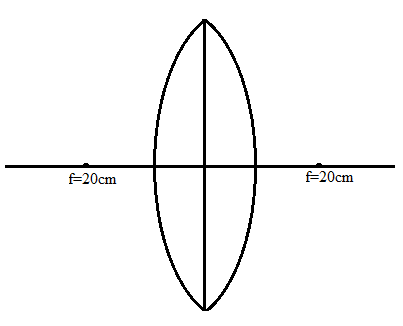
A converging lens has a focal length of 20 cm in air. It is made of a material of refractive index 1.6. If it is immersed in a liquid of refractive index 1.3, find the new focal length.
Answer
576.9k+ views
Hint: Refractive index and focal length of a converging lens in air medium is given. We need to find the focal length of the lens when the medium is shifted from air to liquid. We are provided with the refractive index of the liquid. To find the focal length we have the lens formula. Substituting the known value in the air medium, we get the unknown values in the formula. By this we can find the focal length of the lens in liquid.
Formula used:
Lens formula,
$\dfrac{1}{f}=\left( \dfrac{{{\mu }_{L}}}{{{\mu }_{M}}}-1 \right)\left( \dfrac{1}{{{R}_{1}}}-\dfrac{1}{{{R}_{2}}} \right)$
Complete answer:
We have a converging lens with focal length, f= 20 cm as shown in the above figure.

And the medium in which the lens is present is air.
The refractive index of air is,${{\mu }_{M}}=1$, where $'{{\mu }_{M}}'$ is the refractive index of the medium.
Refractive index of the material of the lens is given,
Let the refractive index of the material of the lens be ${{\mu }_{L}}$, then
${{\mu }_{L}}=1.6$
We know the equation for focal length, i.e. the lens formula,
$\dfrac{1}{f}=\left( \dfrac{{{\mu }_{L}}}{{{\mu }_{M}}}-1 \right)\left( \dfrac{1}{{{R}_{1}}}-\dfrac{1}{{{R}_{2}}} \right)$
$\dfrac{1}{20}=\left( 1.6-1 \right)\left( \dfrac{1}{{{R}_{1}}}-\dfrac{1}{{{R}_{2}}} \right)$
Therefore, we get the value of
$\left( \dfrac{1}{{{R}_{1}}}-\dfrac{1}{{{R}_{2}}} \right)=\dfrac{1}{12}$
Now, we shift the medium from air to liquid.
Refractive index of liquid is given to be 1.3
Therefore the refractive index of the medium now is,
${{\mu }_{M}}=1.3$
We need to find the focal length, for that we have the same lens formula.
$\dfrac{1}{f}=\left( \dfrac{{{\mu }_{L}}}{{{\mu }_{M}}}-1 \right)\left( \dfrac{1}{{{R}_{1}}}-\dfrac{1}{{{R}_{2}}} \right)$
Here, the refractive index of the medium has changed.
We know, $\left( \dfrac{1}{{{R}_{1}}}-\dfrac{1}{{{R}_{2}}} \right)=\dfrac{1}{12}$
Therefore, focal length of the lens when it is immersed in liquid will be,
$\begin{align}
& \dfrac{1}{f}=\left( \dfrac{1.6}{1.3}-1 \right)\left( \dfrac{1}{12} \right) \\
& \implies \dfrac{1}{f}=\left( \dfrac{0.3}{1.3} \right)\left( \dfrac{1}{12} \right) \\
& \implies \dfrac{1}{f}=\dfrac{1}{52} \\
\end{align}$
Focal length is the reciprocal of $\dfrac{1}{f}$.
Hence, focal length of the lens in liquid medium, f=52 cm.
Note:
A converging lens is a type of lens that converges the incident rays towards the principal axis.
This type of lens is relatively thick across the middle and thin at lower and upper edges (refer to the figure given).
Converging lens or a convex lens converges all the beams of parallel rays to a particular point on the other side of the lens. This particular point is known as the focus of the lens. The distance from the optical centre to this point is known as the focal length.
Formula used:
Lens formula,
$\dfrac{1}{f}=\left( \dfrac{{{\mu }_{L}}}{{{\mu }_{M}}}-1 \right)\left( \dfrac{1}{{{R}_{1}}}-\dfrac{1}{{{R}_{2}}} \right)$
Complete answer:
We have a converging lens with focal length, f= 20 cm as shown in the above figure.

And the medium in which the lens is present is air.
The refractive index of air is,${{\mu }_{M}}=1$, where $'{{\mu }_{M}}'$ is the refractive index of the medium.
Refractive index of the material of the lens is given,
Let the refractive index of the material of the lens be ${{\mu }_{L}}$, then
${{\mu }_{L}}=1.6$
We know the equation for focal length, i.e. the lens formula,
$\dfrac{1}{f}=\left( \dfrac{{{\mu }_{L}}}{{{\mu }_{M}}}-1 \right)\left( \dfrac{1}{{{R}_{1}}}-\dfrac{1}{{{R}_{2}}} \right)$
$\dfrac{1}{20}=\left( 1.6-1 \right)\left( \dfrac{1}{{{R}_{1}}}-\dfrac{1}{{{R}_{2}}} \right)$
Therefore, we get the value of
$\left( \dfrac{1}{{{R}_{1}}}-\dfrac{1}{{{R}_{2}}} \right)=\dfrac{1}{12}$
Now, we shift the medium from air to liquid.
Refractive index of liquid is given to be 1.3
Therefore the refractive index of the medium now is,
${{\mu }_{M}}=1.3$
We need to find the focal length, for that we have the same lens formula.
$\dfrac{1}{f}=\left( \dfrac{{{\mu }_{L}}}{{{\mu }_{M}}}-1 \right)\left( \dfrac{1}{{{R}_{1}}}-\dfrac{1}{{{R}_{2}}} \right)$
Here, the refractive index of the medium has changed.
We know, $\left( \dfrac{1}{{{R}_{1}}}-\dfrac{1}{{{R}_{2}}} \right)=\dfrac{1}{12}$
Therefore, focal length of the lens when it is immersed in liquid will be,
$\begin{align}
& \dfrac{1}{f}=\left( \dfrac{1.6}{1.3}-1 \right)\left( \dfrac{1}{12} \right) \\
& \implies \dfrac{1}{f}=\left( \dfrac{0.3}{1.3} \right)\left( \dfrac{1}{12} \right) \\
& \implies \dfrac{1}{f}=\dfrac{1}{52} \\
\end{align}$
Focal length is the reciprocal of $\dfrac{1}{f}$.
Hence, focal length of the lens in liquid medium, f=52 cm.
Note:
A converging lens is a type of lens that converges the incident rays towards the principal axis.
This type of lens is relatively thick across the middle and thin at lower and upper edges (refer to the figure given).
Converging lens or a convex lens converges all the beams of parallel rays to a particular point on the other side of the lens. This particular point is known as the focus of the lens. The distance from the optical centre to this point is known as the focal length.
Recently Updated Pages
Master Class 12 Business Studies: Engaging Questions & Answers for Success

Master Class 12 Economics: Engaging Questions & Answers for Success

Master Class 12 English: Engaging Questions & Answers for Success

Master Class 12 Maths: Engaging Questions & Answers for Success

Master Class 12 Social Science: Engaging Questions & Answers for Success

Master Class 12 Chemistry: Engaging Questions & Answers for Success

Trending doubts
What are the major means of transport Explain each class 12 social science CBSE

Which are the Top 10 Largest Countries of the World?

Draw a labelled sketch of the human eye class 12 physics CBSE

Explain sex determination in humans with line diag class 12 biology CBSE

The pH of the pancreatic juice is A 64 B 86 C 120 D class 12 biology CBSE

Explain sex determination in humans with the help of class 12 biology CBSE




